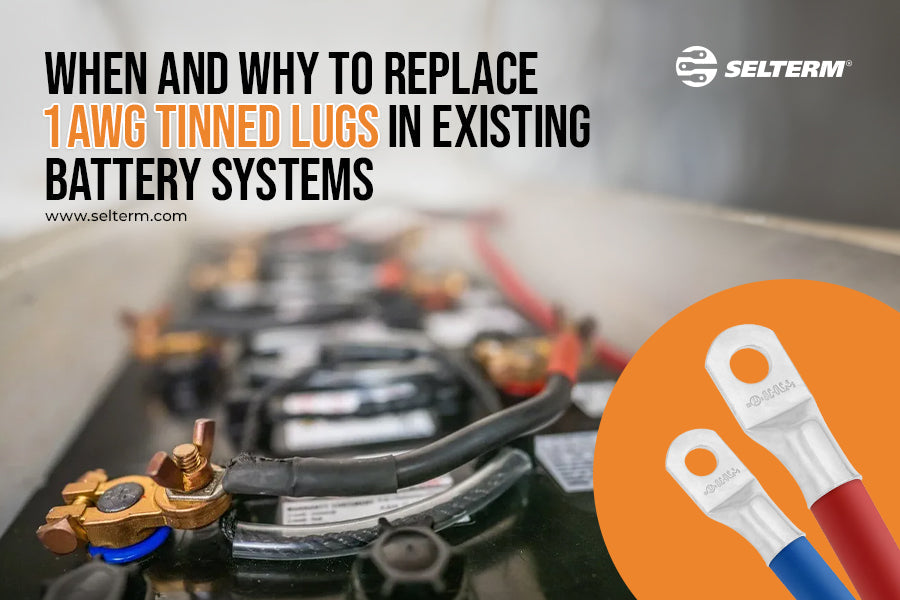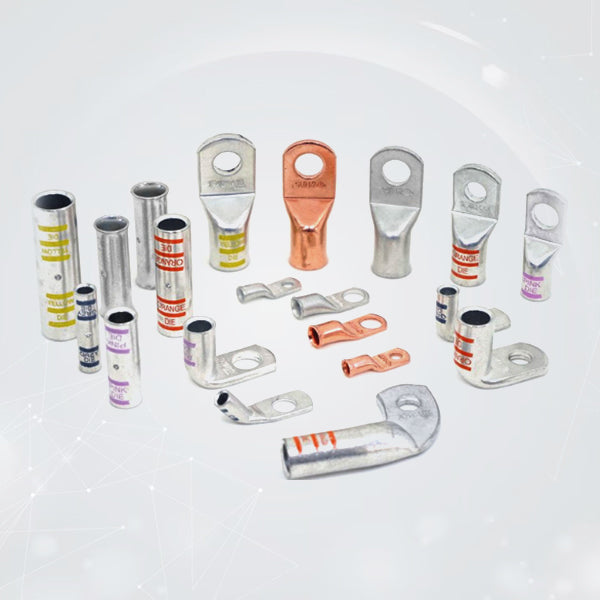
When And Why To Replace 1 AWG Tinned Lugs In Existing Battery Systems
Battery-powered systems, whether in boats, RVs, solar banks, or industrial equipment, rely on one thing above all else: strong, reliable electrical connections. Even the best-designed setup can be compromised if the lugs connecting the cables to the terminals start to fail.
That’s where 1 AWG tinned lugs come in. Made to handle high current loads while resisting corrosion, tinned lugs are the workhorses for many mid-to-large battery systems. But like any component, they don’t last forever. Knowing when to replace them, and how important it is to do so, could save you from an annoying breakdown, unexpected downtime, or worst-case scenario... a complete system failure.
Why 1 AWG Tinned Lugs Are Critical
A 1 AWG tinned lug provides two key advantages:
- Electrical Conductivity: Allows the flow of the electric current while limiting the resistance to the flow through the copper core.
- Corrosion Resistance: The tin plating will not oxidize in a humid, salty environment or even in an outdoor application.
This allows 1 gauge tinned lugs to be an excellent choice for challenging applications where the demands arise from marine power, solar storage, off-grid systems, or heavy-duty vehicle battery banks. But in time, the heat, vibration, and stress from various environmental extremes will have an impact.
Signs It’s Time To Replace Your Lugs
Unlike a blown fuse, failing lugs don’t always announce themselves with a bang. Instead, problems develop slowly. Watch for these telltale signs:
1. Visible Corrosion
Even with tin plating, exposure to salt spray, condensation, or battery acid can eventually break through. If you see greenish or whitish buildup, pitting, or flaking, it’s time for a new lug.
2. Loose Connections
Over time, vibration can loosen crimps or mounting bolts. A 1 AWG tinned lug that doesn’t grip tightly is a weak link. Loose joints increase resistance, which leads to overheating and inefficiency.
3. Overheating
If a connection point feels hot during operation, that’s a red flag. Heat at the lug usually means poor contact or internal corrosion, both of which require immediate replacement.
4. Physical Wear And Tear
Bends, cracks, or deformed barrels compromise the lug’s ability to transfer current. If you see damage from tools, strain, or repeated handling, don’t risk it, replace the lug.
5. Cable Degradation
Sometimes the cable itself shows the issue first. If insulation near the lug is brittle, discolored, or melted, assume the lug has been stressed and swap it out.
Why Timely Replacement Matters
You might be tempted to squeeze a few more months out of an aging 1 gauge tinned lug, but delaying replacement can cost far more in the long run. Here’s why it’s worth addressing issues early:
- Safety: You can create a spark, arc, or worse a fire in larger current systems if you are using corroded or loose lugs.
- Efficiency: Damage and wear add resistance to it, and uses valuable energy from the current system. If your project depends on the efficiency of solar cells or a marine system, the loss of efficiency starts to add up.
- Equipment Protection: Failing lugs can damage terminals, inverters, or batteries themselves. Replacing a $3–$5 lug is far cheaper than replacing a $300 battery.
- Peace of Mind: Knowing your system is protected lets you focus on performance, not potential failures.
Best Practices For Replacement
When replacing 1 AWG tinned lugs, it's more than just ripping off the old and bolting on the new. Here's how to ensure it will work right:
- Pick Quality Lugs: Not all lugs are created equal. Choose UL-listed, high-conductive copper with a durable tin plating. Selterm's 1 AWG tinned lugs are constructed to these demands.
- Match Size: Make sure the lug barrel and stud hole fit your cable and terminal size.
- Prepare the Cable: Cut the end neatly, strip the insulation accurately, and inspect the strands for oxidation before crimping.
- Use the Right Tool: A heavy-duty crimper provides a gas-tight seal to help seal moisture out of the joint.
- Seal with Heat-Shrink: Adhesive-lined heat-shrink tube provides another layer of corrosion resistance and will help as strain relief.
Applications Where Lugs Wear Faster
Not all systems stress lugs equally. If you operate in these environments, inspect your 1 AWG tinned lugs more frequently:
- Marine Environments: Constant salt spray and vibration reduce the life of conductor lugs and fasteners.
- Solar Power Banks: Outdoor temperature swings, rain & UV exposure degrade insulation and sealing.
- RVs and Off-Grid Units: Heavy load cycles and continuous vibration test the limits of conductor lugs.
- Industrial Machines: Heat, oil & dust reduce the life of conductor lugs.
In these cases, proactive replacement is cheaper and safer than reactive fixes.
How Often Should You Replace Them?
There’s no universal timeline, lug life depends on usage and environment. As a rule of thumb:
- Annual Inspections: Check all lugs at least once per year.
- Marine or Harsh Environments: inspect every 6 months.
- Replace Right Now: If you see visible corrosion, looseness, or overheating RIGHT NOW! Do not wait.
Think lugs are like tires; if they are worn, replace them BEFORE they fail completely.
Final Thoughts
Your battery system is only as strong as its weakest link. Even quality, durable 1 AWG tinned lugs can wear out over time, and ignoring the signs of wear and tear can take its toll on efficiency, safety, and costs.
When you inspect your battery system regularly and replace lugs as needed you are helping keep your system dependable, equipment safe, and power flowing as intended.
For high-quality, UL-listed 1 gauge tinned lugs built to handle demanding applications, check out Selterm’s collection. A small investment in replacement today can prevent big problems tomorrow.

